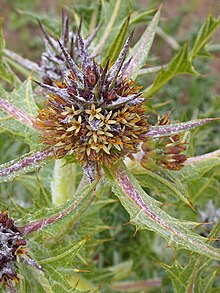| Gundelia | |
|---|---|

| |
| Gundelia tournefortii | |
| Scientific classification | |
| Kingdom: | Plantae |
| Clade: | Tracheophytes |
| Clade: | Angiosperms |
| Clade: | Eudicots |
| Clade: | Asterids |
| Order: | Asterales |
| Family: | Asteraceae |
| Tribe: | Cichorieae |
| Subtribe: | Scolyminae |
| Genus: | Gundelia L. |
| Type species | |
| Gundelia tournefortii | |
| Synonyms[1] | |
|
Gundelsheimera Cass. | |
Gundelia or tumble thistle[2][3][4] is a low to high (20–100 cm) thistle-like perennial herbaceous plant with latex, spiny compound inflorescences, reminiscent of teasles and eryngos, that contain cream, yellow, greenish, pink, purple or redish-purple disk florets. It is assigned to the family Asteraceae. Flowers can be found from February to May. The stems of this plant dry-out when the seeds are ripe and break free from the underground root, and are then blown away like a tumbleweed, thus spreading the seeds effectively over large areas with little standing vegetation. This plant is native to the eastern Mediterranean and the Middle-East. Opinions differ about the number of species in Gundelia. Sometimes the genus is regarded monotypic, Gundelia tournefortii being a species with a large variability, but other authors distinguish up to nine species, differing in floret color and pubescence. Young stems are cooked and eaten in the Middle-East and are said to taste like a combination of artichoke and asparagus.
- ^ Flann, C (ed) 2009+ Global Compositae Checklist
- ^ Hind, Nicholas (2013). "Plant Portraits - 763. Gundelia tournefortii". Curtis's Botanical Magazine. 30 (2): 114–138. doi:10.1111/curt.12027.
- ^ "Gundelia tournefortii". Flowers in Israel. Retrieved 2016-12-02.
- ^ Avinoam Danin. "Gundelia tournefortii L." Flora of Israel Online. Retrieved 2016-12-14.